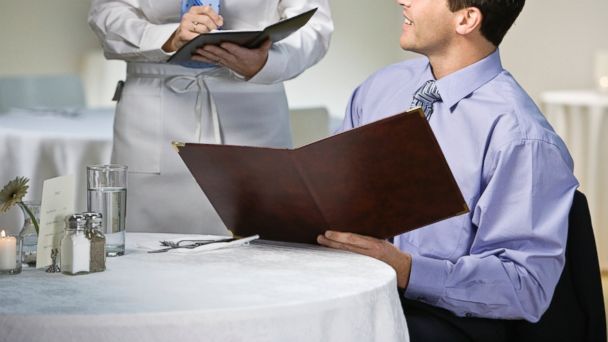9 Sneaky Tricks to Avoid On Restaurant Menus

Careful! What really contributed to you ordering a certain dish? (Credit: Getty Images)
You may think you're choosing what you most want to eat from a restaurant's menu, but research says otherwise. Menu consultants exist purely to make you order the more expensive and most profitable dishes from a restaurant's menu through design tricks.
"Middle class chain restaurants like Olive Garden, Hooters and TGI Friday's are really on the cutting edge of menu science because they have standardized menus and look at what's selling and what's not," William Poundstone, author of "Priceless: The Myth of Fair Value (and How to Take Advantage of It)" said. "And they do everything they can to increase their profits from it." Break the cycle by identifying the nine most common decoys restaurants employ.
Upper Right-Hand Corner: Despite thinking you might look at the top left of a menu first (because that's how we read), people's eyes gravitate toward the upper right-hand corner of a menu first, according to time and emotion studies. "They try to make it catch your attention, and it's where they often put the anchor," Poundstone said.
The "Anchor": Employed as a tactic in retail stores as well, the anchor helps sell the most profitable items on a menu. "It's some ridiculously expensive item that they don't expect people to buy," Poundstone said. "But just having it there will make everything look reasonably priced in comparison."
Right Next Door: "If you go into Louis Vuitton, they'll have a $20,000 handbag, and they won't sell many of those, but next to it will be a $2,000 handbag that looks pretty good in comparison. It's the same principal," Poundstone said. Knowing your eyes will land on the anchor and move away from it because it's so pricey, putting the dishes with the highest profit margins nearby makes you more likely to settle on those. They're comparatively cheaper and so seem like a good deal, yet still expensive.
Pictures of Food: Not many restaurants employ this tactic because it can cheapen the look of a menu, but it's still a large order driver. "The food that's illustrated gets ordered more than ones that don't, so the food they have pictures of are ones they get more profit on," Poundstone said. Fancier restaurants sidestep this taboo by including a few tasteful illustrations.
Killer Columns: "Cheaper customers will look down and choose from the three cheapest things," Poundstone said. Restaurants much rather prefer you look at the food descriptions, so they'll center align a list to make it more difficult. "It's a small thing but when you're looking at a menu, you're not concentrating on it. You're trying to make witty table conversion and checking out the room and you're very distracted, so it's very easy to nudge you to take the past of least resistance," Poundstone said. "So in that situation, if it's harder to check the price, you won't even do that. You'll just choose what seems to be the best thing and pick it."
Poetic Language: Restaurants will do whatever they can to catch a diner's attention. "They'll use a lot of terms that don't really mean a whole lot, like 'beet roots.' Beets are roots, but 'beet roots' is so much more poetic than just beets," Poundstone said. By using complicated language, the restaurant draws your attention away from the price and onto the food.
Boxes: A box just serves to call your attention to something. "If a magician points to the right side of the stage, everyone looks there and won't see him loading the rabbit into his hat," Poundstone said. "And the box does the same thing. If someone is in caps and in bold, you'll be more likely to look at that and order that. It's really amazing how easy it is to manipulate people."
Siberia: Just like studies show diners first look at the upper right-hand corner of a menu, they also look at the bottom left last. So restaurants will put the least expensive dishes down there. "Hamburgers are often the case. They don't want to get rid of that dish entirely because there are long-time customers who like it or they're afraid people might stop coming, so they keep it on the menu, but they make it as hard to find as possible," Poundstone said.
Bracketing: "This is the jargon for when a dish comes in different sizes, like a regular salad and half salad," Poundstone said. "That's a great way of deceiving people because you don't know how big it's going to be, but it kind of pleases everyone." People ordering the smaller portion figure they're saving money or keeping in line with their diet, and others ordering the larger portion think they're getting more bang for their buck or can get two meals out of it, despite not knowing how big the portion actually is.